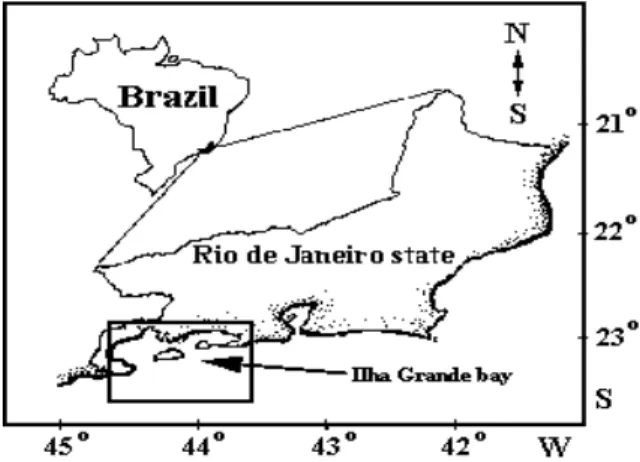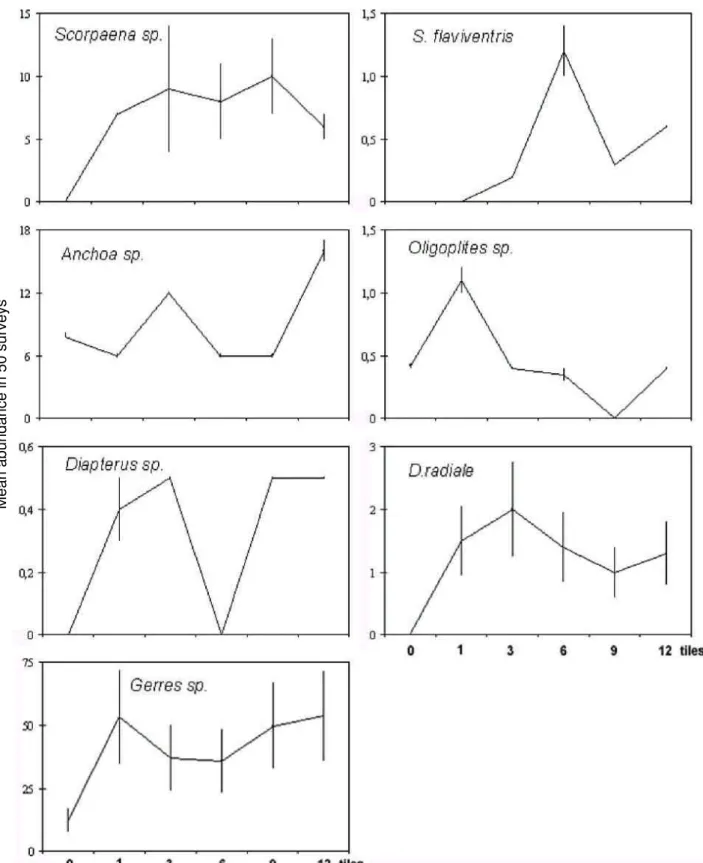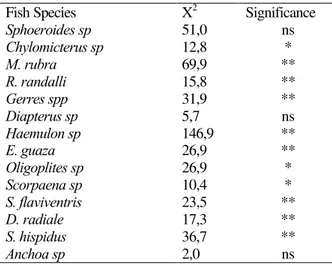Vol. 44, N. 3 : pp. 319 – 324, September, 2001
ISSN 1516-8913 Printed in Brazil
BRAZILIAN ARCHIVES OF
BIOLOGY AND TECHNOLOGY
A N I N T E R N A T I O N A L J O U R N A L
Habitat Selection by Fish in an Artificial Reef in Ilha
Grande Bay, Brazil
Daniel Shimada Brotto
1and Francisco Gerson Araujo
2*1
Universidade Veiga de Almeida, Depto. Ciências da Saúde, rua Ibituruna, 108, CEP. 20271-020, Rio de Janeiro - RJ, Brazil; 2Universidade Federal Rural do Rio de Janeiro, Laboratório de Ecologia de Peixes, km 47 - Antiga Rodovia Rio - São
Paulo, Seropédica - RJ, Brazil
ABSTRACT
The use of artificial structures as a shelter for fishes was evaluated aiming to assess increase in fish abundance in Ilha Grande Bay at Southeast Brazilian coast (Lat: 22o8'-23o5' S; Long. 44o05’-44o40’W). Five different types of structures, made of clay tiles, with an increase range on size and complexity were tested to assess their efficiency. Fish were counted in each type of structure from May-1996 to April-1997 by underwater observation made with snorkelling. According to the pattern of concentration in the structures, two groups of fishes were identified. One comprised by E. guaza, M. rubra, R. randalli, S. hispidus, Sphoeroides sp and Haemulun sp showed affinity for hard bottom, irregular profile and an increase in abundance on the more complex and biggest structures. The other comprised by Chylomicterus sp, Gerres spp, Anchoa sp, Diapterus sp, Oligoplites sp and D. radiale did not present clear preference for hard bottom.
Key words: Artificial Reefs, Brazil, Fish, Habitat selection
* Author for correspondence
INTRODUCTION
Coastal zones rank among the most endangered marine ecosystems. Artificial reefs, which consist of submerse structures showing an ample variety of form, materials and compositions, were though to be a possible solutions for this problem. In the last three decades several authors have been working on this area as Carslile et al. (1964), Davis (1985), Yokouchi et al. (1991) and Ambrose (1994).
In Brazil the avaiable literature on this subject is limited to reports and meeting proceedings, hence formal scientific information is still lacking. A year round project for assessing patterns of habitat colonisation by fish species on different types of structures was developed in Ilha Grande Bay (Latitude: 22o8' - 23o5'), at Rio de Janeiro State, Brazil (Figure 1).
The aim of the present work was to test different forms and complexity of low costing artificial reefs to evaluate their use as shelters by fish.
Five types of structures made of 41 X 22 cm baked clay tiles were arranged in an increasing complexity pattern using one, three, six, nine and twelve tiles in each type, with five replications each (Figure 2). These structures and five control sites (no tile) were deployed randomly along five parallel rows on sandy bottom, at 1,5 to 2 meters deep, about 10 m away from the shoreline.
Figure 2 - Schematic draw of the types of structures.
From May 1996 to April 1997, a total of 46 weekly surveys of underwater observations made by snorkelling were performed in each structure. In each survey all the 25 structures and the 5 control sites were inspected. A plastic sheet was used for recording overall fish abundance.
Only the fishes that occurred in more than 10 percent of the total number of surveys (frequency of occurrence - FO >10%), were considered in the analysis, with FO calculated as follow:
The abundance of fish among the different types of structures were compared by Kruskal-Wallis analysis, in order to identify possible affinities for a certain type of structure.
Twenty fish species were recorded, comprising 22
genera and 22 families. Haemulon spp were
constant in almost all sampling (FO = 98) and showed the second highest contribution to the total abundance of fish, amounting 25% of all fish. Juvenile Gerres spp were the most abundant fish group, amounting 51.2% of all fish counted and presenting FO = 81,6. Sphoeroides sp were also high frequent in the sampling although with low contribution in total abundance (Table 1).
Table 1 - Frequency of occurrence, total and percentual abundance of fish.
According to each kind of structure, different patterns of abundance were observed for each fish group, and these patterns seemed to be related to habitat requirements of such fishes.
The serranids E. guaza, M. rubra, R. randalli, haemulidae Haemulun sp, monacantid S hispidus,
tetraodontiforms Sphoeroides sp and
Chylomicterus sp showed direct relationship
Figure 3 - Mean abundance of analysed fish species that presented increasing pattern by type of structure.
On the other hand, no clear association was observed between the complexity and dimensions of structures and abundance of Scorpaena sp,
Gerres spp, Diapterus sp, Anchoa sp,
S. flaviventris, Oligoplites sp. Furthermore, D.
radiale seemed to occur in higher abundance in
simpler structures (Figure 4).
Figure 4 - Mean abundance of analysed fish species that presented no increasing pattern by type of structure
The Kruskal-Wallis analysis showed that there were significant differences among almost all fish
species abundance analysed by type of structure (Table 2).
Table 2 - Values of X2 and significance of the difference among fish abundance among types of structures.
Fish Species X2 Significance
Sphoeroides sp 51,0 ns
Chylomicterus sp 12,8 *
M. rubra 69,9 **
R. randalli 15,8 **
Gerres spp 31,9 **
Diapterus sp 5,7 ns
Haemulon sp 146,9 **
E. guaza 26,9 **
Oligoplites sp 26,9 *
Scorpaena sp 10,4 *
S. flaviventris 23,5 **
D. radiale 17,3 **
S. hispidus 36,7 **
Anchoa sp 2,0 ns
ns = non significant, * = 0,01< p < 0,05, ** = p < 0,01
An attempt to adapt the patterns presented, by the surveyed fish species in this work to the classification of Ogawa (1982) for fishes associated to artificial reefs is presented in Table 3.
Table 3 - Types of fish (Ogawa, 1982), pattern, and observed species.
DISCUSSION
The majority of serranids presented higher abundance in the bigger and more complex type of structure, as this group comprised by predators that sought shelter in cavities and rock outcrops (Hobson 1965, 1972; Collete & Talbot 1972). Beets & Hixon (1994) also observed higher abundance of serranids in artificial reefs structure provided by high number of cavities.
S. hispidus and Chylomicterus sp presented higher
abundance related to the bigger structures as they preyed mainly on invertebrates that occurred on hard bottoms. The unclear pattern observed for S.
flaviventris was probably related to the small size
of this species that imposed few spatial requirements. For D. radiale the higher abundance observed in smaller structures could be related to a diet based on soft bottom organisms or competition with other serranids.
Fishes of the genus Haemulon spp, Gerres spp,
Sphoeroides sp and Scorpaena sp, presented
different patterns of abundance among structure. For this groups, affinity for hard bottoms of irregular profile was not evident, as they didn't show significant differences in abundance, according to increasing structure complexity. Perhaps as suggested by Patton et al. (1985), in some cases, a homogeneous scattering of structures in an ample area would show better results than pilling these structures.
This experiment has shown that the deployment, colonisation and monitoring of an artificial reef is something more complex than just throwing outboard any kind of scrap without proper planning and study, claiming to increase in fish productivity.
In Brazil, artificial reefs are often considered as tools for fish concentration aiming to help fisheries, rather than an option for environmental restoration.
O uso de estruturas artificiais como abrigos por peixes, foi avaliado objetivando o incremento da abundância de peixes na baía da Ilha Grande na costa da região sudeste brasileira. Cinco diferentes tipos de estruturas, feitas de telhas de barro, de crescentes tamanhos e complexidades foram testadas para avaliar sua eficiência como abrigos de peixes. Os peixes associados a cada tipo de estrutura foram contados, semanalmente de maio/1996 a abril/1997, através de observações subaquáticas realizadas por mergulho livre. De acordo com os padrões de abundância, dois grupos de peixes foram identificados. O primeiro formado por E. guaza, Chylomicterus sp, Sphoeroides sp M.
rubra, R. randalli, S. hispidus, e Haemulun sp
apresentou afinidade por fundos duros de relevo irregular cuja abundância proporcional ao tamanho e complexidade das estruturas, e o outro formado
por S. Flaviventris, Scorpaena sp, Diapterus sp,
Gerres spp, Anchoa sp, Oligoplites sp, e
D. radiale que não apresentou ocorrência
associada com as estruturas.
REFERENCES
Ambrose, R. F. (1994), Mitigating the effects of a coastal power plant on kelp forest community: rationale and requirements for na artificial reef. Bull. Mar. Sci.. 55, 694-708
Virgin islands Bull. Mar. Sci. 55, 470-483
Carlisle Jr, J. G.; Turner, C. H. and Ebert, E. E. (1964), Artificial habitat in the marine environment. Fish. Bull. (124) The resour. agen. of Calif., Dept of Fish and Game, 93p
Collette, B. B. and Talbot, F. H. (1972), Activity patterns of coral reef fishes with emphasis on nocturnal-diurnal changeover. Bull. Natur. Hist. Mus. of Los Ang. County. 14, 98–178
Hobson, E. S. (1965), Diurnal – nocturnal activity of some inshore fishes in the Gulf of California. Copeia,
3, 291-302
Hobson, E. S. (1972), Activity of Hawaiian reef fishes during the evening and morning transitions between daylight and darkness. Fish. Bull. 70 (3), 715-740 Ogawa, Y. (1982), Jinko giosho, tsukiiso, and marine
organisms. In Vik, S.F.(ed.), Japanese artificial reef technology. Aquabio, Inc., 2957 Sunset Blvd., Bellair Bluffs, Fl. Technical Report 604p
Patton, M. L.; Grove, R. S. and Harman R. F. (1985), What do natural reefs tell us about designing artificial reefs in southern California. Bull. Mar. Sci. 37, 279-298
Yokouchi, H.; Yamamoto, R. and Ishizaki, Y. (1991), Construction of artificial seaweed bed accompanied with the land reclamation for unit no 3 of Ikata Power Station. Marine Pollution Bulletin23, 719-722




